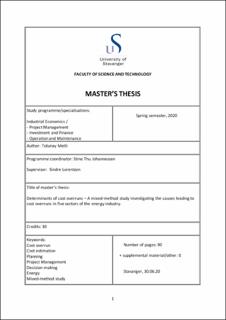| dc.contributor.advisor | Lorentzen, Sindre | |
| dc.contributor.author | Metli, Tolunay | |
| dc.coverage.spatial | Norway | en_US |
| dc.date.accessioned | 2021-04-20T07:24:06Z | |
| dc.date.available | 2021-04-20T07:24:06Z | |
| dc.date.issued | 2020-07-01 | |
| dc.identifier.uri | https://hdl.handle.net/11250/2738477 | |
| dc.description | Master's thesis in Industrial Economics | en_US |
| dc.description.abstract | This thesis focuses on the causes leading to cost overruns in energy projects. The motivation to write about this subject arose from discovering the fact that most companies avoid releasing accurate information surrounding costs of their projects, and for this reason, few studies have been done on the subject matter. While researching this subject, the author came to the conclusion that the explanation behind the occurrence of cost overruns would be complex, and that a single method of study would not be sufficient to comprehensively answer the research question. Therefore, a mixed-method study was chosen.
The result of using a mixed-method study has led to the analysis of quantitative data from 424 projects, which was then mixed with a set of quantitative and qualitative data from a variety of sources, making this a comprehensive study on this topic. The focus of this thesis has been on the accuracy of information available at the time of decision to approve the initiation of a project, i.e. project sanctioning, and should only be interpreted as such.
The author has found that bias, deception and lack of understanding of risk and complexity are widespread in the energy industry. The results indicate that projects in the nuclear sector experience cost overruns regardless of their size (indicated by budget and capacity), proposed project time or completion date within its sector. These projects had the highest average and frequency of cost overruns of any sector. Meanwhile, hydro projects represented the highest average cost overruns in total dollars of any sector. Oil and gas projects showed better forecasting performance, but still had arguably high average and frequency of cost overruns. On the other hand, wind and solar projects had high degrees of standardizations with shorter project lead times and were the least risky options of all the sectors. | en_US |
| dc.language.iso | eng | en_US |
| dc.publisher | University of Stavanger, Norway | en_US |
| dc.relation.ispartofseries | Masteroppgave/UIS-TN-ISØP/2020; | |
| dc.rights | Navngivelse 4.0 Internasjonal | * |
| dc.rights.uri | http://creativecommons.org/licenses/by/4.0/deed.no | * |
| dc.subject | industriell økonomi | en_US |
| dc.subject | industrial economics | en_US |
| dc.subject | cost overrun | en_US |
| dc.subject | cost estimation | en_US |
| dc.subject | planning | en_US |
| dc.subject | project management | en_US |
| dc.subject | prosjektledelse | en_US |
| dc.subject | decision-making | en_US |
| dc.subject | energi | en_US |
| dc.subject | mixed-method study | en_US |
| dc.title | Determinants of cost overruns – A mixed-method study investigating the causes leading to cost overruns in five sectors of the energy industry. | en_US |
| dc.type | Master thesis | en_US |
| dc.subject.nsi | VDP::Samfunnsvitenskap: 200::Økonomi: 210::Bedriftsøkonomi: 213 | en_US |

